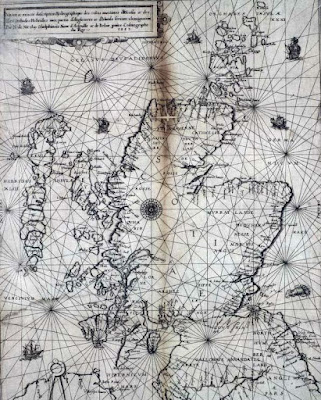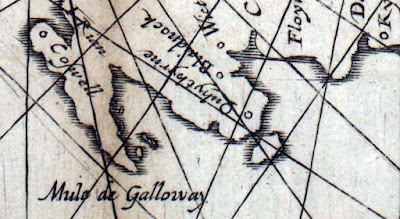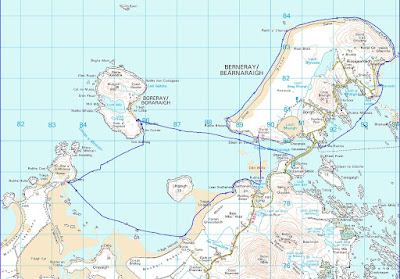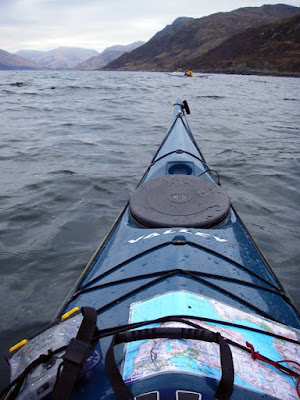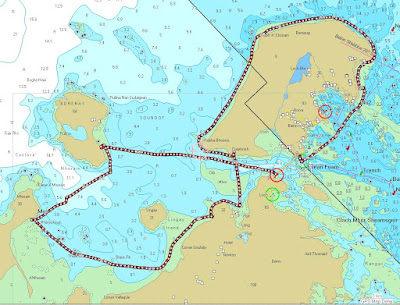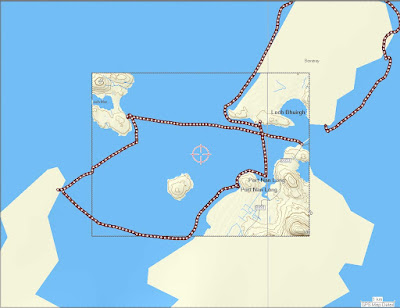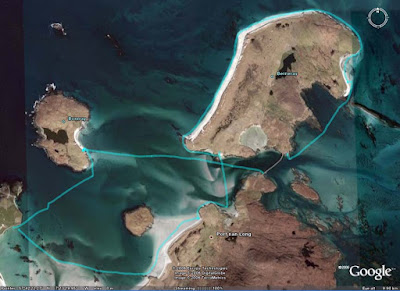
A version of this test first appeared in UK Paddles magazine in April 2006.
There have been a number of changes in the UK sea kayak manufacturing scene recently. P&H are now moving forward as part of the Pyranha stable and Valley are now run by Pete Orton and Jason Buxton who formerly worked at P&H. This test was a chance to see how the new Valley team were doing and involved an exciting new design for the keen paddler; the Nordkapp LV. It was supplied by a dealer new to Valley; Scottish Paddler Supplies.
Testing took place over the Scottish winter, spring and early summer and in a variety of conditions and locations in Scotland.

Scarp in the Outer Hebrides.

Loch Nevis in the north west.

St Abbs Head and

Coldingham in the south east.

The north coast of Rum. Inner Hebrides.

The Gulf of Corryvreckan.

Various locations in the Firth of Clyde and the Solway in the south.

Finally to the Ecrehous reef between Jersey and France.
The boat was paddled alongside reference boats including 2005 Rockpool Alaw and Alaw Bachs, 2005 Nordkapp Jubilee and 2005 P&H Quest. The various male and female testers weighed between 60 and 90 kg and experiences ranged between intermediate to expert. Conditions ranged from force 1 to Force 6 gusting 8, onshore and offshore with a variety of water conditions.
The Valley Nordkapp LV.

This is the most beautiful sea kayak I have ever seen. It is a series of graceful curves and flowing lines. The only straight line is the “V” on the fore deck. Even the keel is highly rockered. Compared with the Nordkapp Jubilee, this boat is a completely new shape. The only dimension it shares with its namesake is overall width. It has much finer bow and stern sections.
Construction, finish and ergonomics.
In the recent test of the Point 65 boats from Sweden, I commented that their finish was superior to some contemporary UK boats. Then last year Rockpool produced their stunningly well finished boats and now Valley have joined them, putting UK manufactures at the top of the quality tree. The finish on this boat is absolutely superb. Including keel strip and ready for the water it weighs 24kg and even smaller women commented on how easy it was to lift. In comparison, the Alaw was 26.5 kg but it does have a thicker lay up on the hull and has proved itself in close contact rockhopping.
The deck lines, fittings and end toggles are all good well proven Valley items. The seat back is supported by four straps that attach to the seat pan and rear bulkhead. It is comfortable and the straps prevent it folding forward under your bum during wet re-entries (unlike other designs which use shock cord). The seat pan is a new plastic moulding. It is lightweight and has a removable pad which gets wet and can’t be wiped dry. This will mean you will get a wet bottom if you like to paddle in shorts in the summer. The three largest paddlers had to remove the seat pad to physically get their thighs under the cockpit rim. (Neoprene pads are supplied unfitted for thinner paddlers to glue under the cockpit coaming.) All still found the unpadded seat and relatively straight legged position to be very comfortable. If you are too big to fit in, it is possible to remove some of the foam under the seat and fit shims under the cockpit coaming. If this still does not give enough room, I would be tempted to remove the seat and replace it with a foam seat. The long keyhole cockpit with a low foredeck makes it one of the easiest boats to get in or out of.
The skeg operated faultlessly and the exposed section of the cable (which is liable to kink in other designs) was enclosed by a stainless steel sleeve. The wire is still easy to remove for lubrication. The hatches were all Valley’s own design. The front one was oval. They were difficult to get on and off with cold fingers but were completely waterproof despite several wet sessions. The footrests are adjustable Yakima pegs on an alloy track which is attached by bolts through the hull. When new these adjusted easily but after a rolling session in a sandy bay, they jammed. Paddlers with small feet found their position comfortable but those with larger feet found the curve of the hull limited contact with the pedals. In contrast, the adjustable, angled full footplate on the Rockpools was so much more comfortable. For a personal boat I would consider not ordering the footrests, order a custom bulkhead and make a large footpad from ethafoam.
Performance.
They said: "Designed for either the lighter paddler who wants an expedition proven sea kayak or a larger paddler who wants the legendary performance of the full sized Nordkapp but wants more manoeuvrability and doesn't need the full carrying capacity of the full sized version." Two friends have Nordkapp Jubilees and I have enjoyed paddling both when fully loaded, but even with my weight of 85 kg, I find them bouncy when unloaded in a chop with wind. I was really looking forward to the Nordkapp LV
This boat feels so, so alive and responsive! It lacks the initial tippiness of an unladen Nordkapp Jubilee but it is so responsive to the slightest lift of a knee and this (together with the boat’s response to the bow rudder stroke) made manoeuvring round the labyrinth of tight rocky channels of St Abbs an absolute joy. A much more experienced paddler, following in the Aquanaut, could not match the tight lines this boat took. The Rockpool Alaws are designed for manoeuvrability but the Nordkapp LV could match every turn. However, as you edge an Alaw the boat becomes progressively stiffer and more secure feeling, as you edge the Nordkapp LV it just keeps going over smoothly until sploosh. There is no warning when you are just about at the limit of secondary stability. Intermediates learning edging and bow rudder strokes found the Alaws to be much easier.
I was expecting it to be manoeuvrable, given all that keel rocker, but I was not expecting it to be fast. However, it accelerates to top speed with fewer strokes than any other boat I have paddled. And what a burst speed it has! The Nordkapp LV managed 11.6km/hr. In comparison; the Quest managed 10.5 km/hr, the Alaw 10.1km/hr, the Jubilee 9.8km/hr and the Aquanaut 8.6km/hr. This top speed is just the thing if you need to power round a headland against a tide but in truth all the boats seemed to settle down nicely at 6.9km/hr, my usual cruising speed.
This boat handles rough water. It thrives in wind against tide or a combination of overfalls and clapotis under a headland. Like many Valley designs it tends to throw its bow high over approaching steep waves. In strong winds in an unladen Jubilee or Aquanaut this can result in the bow getting blown downwind. In the Nordkapp LV this does not happen. However, it is quite a wet boat and you will need to have a well fitting spray deck. Above force 4 it starts to weathercock and although you can control this with edging, the skeg makes for a much more relaxed paddle on an exposed crossing. The Alaw Bach has no skeg but is a very well balanced boat even in strong winds. However, paddling it side by side with the LV in force 5 to 6 winds demonstrated the extra versatility given by the Nordkapp LVs skeg. You might not need it very often but when you do, it does make life much easier. We had planned a day to the Cuan Sound to see how the Nordkapp LV handled tidal eddy lines. Unfortunately, the boat arrived too late so we took it to the tidal weir at the mouth of the River Doon. The jet coming out the weir was travelling at 26km/hour and the boat handled crossings like a dream.

Crossing the eddyline at the tidal weir on the Doon.
With such a narrow stern, I was not expecting the Nordkapp LV to be able to pick up following seas as easily as a boat like the Alaw. I was wrong, the Nordkapp LV’s acceleration means you can pick up swells actively rather than relying on the hull shape of the stern to give you that final boost to catch a wave. I managed a burst speed 18.6km/hr on a nice piece of Solway surf! This brings me to rolling. The LV rolls very easily. It is also very easy to re-enter and roll the boat; the straps keep the back rest well out of the way. In a rescue situation, it is very easy for the rescuer to completely empty the Nordkapp LV simply by raising the bow and using the bow rocker as a lever to twist the boat upside down. The Alaw has less bow rocker and is more difficult to twist over.

What about the LV’s use as an expedition boat? Well there was not much enthusiasm for camping at this time of year but I tried it loaded with 40kg of weight. Together with my weight of 85kg plus 10kg for clothing and safety gear, this brought the waterline up to the deck seam. Heavy weights can use it as an expedition boat if they accept having less volume for bulky items than a Nordkapp or a Quest. When the Nordkapp LV is loaded it has a much more predictable limit of secondary stability. This means that if you are light and value secondary stability, it might be best to view this as an expedition boat rather than as a day boat.

In the fore hatch I managed to fit in a 3 man tunnel tent, 5mm full length Thermarest, down sleeping bag, Force 10 4 man mountain shelter, oddment dry bag with SLR size camera, radio, car keys, spare batteries etc. and a 1 litre wide mouth nalgene bottle with repair kit. In the cockpit, I had a six litre water bag and I am sure there would be room for my Kelly Kettle in place of a knee tube. In the stern hatch I had a folding stool, walking boots, two dry bags with clothes, toilet bag, folding bowl, folding wind shield, MSR 1.5l/1.0l/frying pan cookset with mini stove inside, large gas cylinder, two cups, bowl, plate, cutlery, kitchen roll and kindling, firelighters and lighter for Kelly Kettle. The day hatch was free for food etc. Despite its LV name, this is still an expedition boat.
Dimensions.
As measured rather than quoted: Length 532cm, breadth 53cm, cockpit 79cm x 40cm, height of cockpit front 33cm, weight standard construction with keel strip 24.0kg.

Hull plan shapes.
Conclusion.
The Valley Nordkapp LV is a superbly made expedition boat for smaller paddlers. It is as manoeuvrable as a day boat (albeit at the cost of some secondary stability) and it is also fast. Valley seem to have achieved the Holy Grail of sea kayak design: the LV has speed, manoeuvrability and sufficient volume! It is a boat that the progressing paddler will delight in for its excitement and responsiveness. It is also a superb day boat for heavier paddlers while still having enough expedition carrying capacity for all but the heaviest of packers. What else should you consider? Early intermediates looking for a day boat should also try the superb Rockpool Alaw Bach which is just as manoeuvrable but is a more predictable learning platform that will flatter ability and speed skill development. Hardcore rockhoppers should also consider the Rockpool for its heavier and stronger construction and in extreme conditions even experts appreciate secondary stability.
What is the overall verdict of the Valley Nordkapp LV? Well apart from carrying capacity, we could not find a single criterion in which the Nordkapp Jubilee retained superiority. The Nordkapp is dead. Long live the Nordkapp LV! It is outstanding, beauty really isn't skin deep! As a result of this test, three Nordkapp LV’s have already been ordered and more are being saved for! I feel I must award this boat 12/10!
Footnote.
Since this review was published, several friends and I have bought Nordkapp LV's. Experience since then has not changed any of the conclusions above. Mine developed a leak from where the skeg cable enters the skeg box. It was fixed without question and returned within 3 days. I have used it successfully for weekend camps but I chose to take my Quest for a 10 day trip to the Outer Hebrides due to its greater carrying capacity . The plastic seat fitted to 5 boats supplied in the spring and early summer of 2006 were fitted much higher than in the tested demo boat. Indeed two purchasers were physically unable to fit into their own boats despite having fitted in the demo. Slimmer purchasers found their boats to be tippier than the demo boat. Valley sent us a batch of alternative plastic seats which allowed lower fitting. This was achieved by removing foam from under the seat and shimming the resulting space under the cockpit and the top of the seat mounts. The Nordkapp LV has only been available with the plastic seat but it was noted that a 2006 Nordkapp with a plastic seat had
its seat 4.5cm higher than a 2005 Nordkapp Jubilee with the original GRP seat. This problem is not restricted to Valley. P&H plastic seats are also fitted higher than their GRP seats but at least P&H still offer the GRP seat as an option.
Second footnote.
Jonny asks:
I am just wondering if anyone has experience of this boat in reasonably big surf. (5-8ft). I live in Cape Town, South Africa. Often I will need to beach with the surf pumping. Getting out is never a problem.
Just hoping that this boat does not nose dive, and wondering how it handles sitting on the wall of a wave?
Jonny the Nordkapp LV's ability in surf outdoes my abilites, so I will just answer by posting a sequence of photos of my friend Cailean MacLeod coming in through the surf in at Coldingham.
Does that answer your question? :o)


















